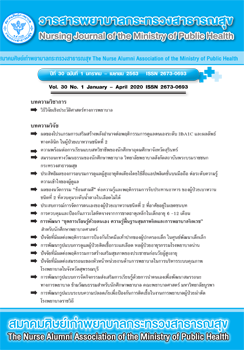Readiness for Interprofessional Learning among Undergraduate Students in Surin Province
Main Article Content
Abstract
This descriptive study was aimed to determine and compare the level of readiness for interprofessional learning (IPL) among undergraduate students in Surin Province. The sample consisted of 719 undergraduate students studying at the Boromarajonani College of Nursing Surin, Surin Rajabhat University, and Rajamangala University of Technology Isan. The Readiness for Interprofessional Learning Scale (IPL) was used to collect data in which the Cronbach’s Alpha coefficient was .91. Independent t-test and one-way ANOVA were utilized to compare the differences in the means of the readiness for IPL. The majority of the participants were female, Buddhists, never had experience with IPL, studying at the Rajabhat University, and the first year students. Overall, the sample had a high level of readiness for IPL. There were statistically significance differences in readiness levels among the students with regards to gender, different institutes, and experience with IPL but not statistically different regarding different years of study. The suggestion from this study is that all institutes located in Surin province should consider integrating interprofessional education in their curriculum and can launch IPE in the first year of the program.
Article Details
บทความและรายงานวิจัยในวารสารพยาบาลกระทรวงสาธารณสุข เป็นความคิดเห็นของ ผู้เขียน มิใช่ของคณะผู้จัดทำ และมิใช่ความรับผิดชอบของสมาคมศิษย์เก่าพยาบาลกระทรวงสาธารณสุข ซึ่งสามารถนำไปอ้างอิงได้
References
2. World Health Organization. Learning together to work together for health. Report of a WHO study group on multiprofessional education of health personnel: The team approach, technical report reries 769;1987 October 12-16; Geneva. Geneva: World Health Organization,1988.
3. Hammick M, Freeth D, Koppel I, Reeves S. A best evidence systematic review of interprofessional education: BEME Guide no.9. Med Teach 2007;29:735-51.
4. Wannakrairot P, Rujkornkran D, Buranatrivej S, Wisaijorn T, Preeyanon L. Suggestion for health care professional education in some area: For institutional and education reform. Bangkok: The Graphico System ltd; 2019. (in Thai).
5. Barr H. An anatomy of continuing interprofessional education. Journal of Continuing Education in Health Professions 2009;29:147–50.
6. Chuenkongkeaw W. Interprofessional Education 2nd edition. Bangkok: P.A. Living; 2018. (in Thai)
.
7. Yeunyow T, Howharn C, Promsuan W. Effects of interprofessional education on perception on interprofessional roles and responsibility, and teamwork. Nursing Public Health and Education Journal 2019;20(1):137-47. (in Thai).
8. Oeseburg B, Hillberts R, Luten TA, Etten A, Slaet JPJ, Roodbol PF. Interpfrofessional education in primary care for the elderly: a pilot study. BMC Medical Education 2013;13:161.
9. Rukroong K, Rukroong K, Tanchan K, Netwong K, Porkpipat K, Chanmake K, et al. Readiness for interprofessional learning of sophomore and junior nursing students at Boromarajonani College of Nursing, Suratthani. The 6th Active Learning Conference: How Active Learning answer Thailand 4.0. Suratthani, Walailak University. 2018. (in Thai).
10. Visser CLF, et al. The association of readiness for interprofessional learning with empathy, motivation, and professional identity development in medical students. BMC Medical Education 2018;18:125. Doi.org/10.1186/s12909-018-1248-5.
11. Mc Fadyen AK, Webster V, Strachan K, Figgins E, Brown H., McKechnie J. The readiness for interprofessional learning scale: A possible more stable subscale model for the original version of RIPLS. Journal of Interprofessional Care 2005;19(6):595-603.
12. Zhewei L, Yihan S, Yang Z. Adaptation and reliability of the readiness for interprofessional learning scale (RIPLS) in the Chinese health care students setting. BMC Medical Education 2018; 18:309. doi.org/10.1186/s12909-018-1423-8.
13. Srisaard B. Interpretation of estimation scale data collecting tool. Journal of Educational Measurement Mahasarakham University 1994;2(1):64-70. (in Thai).
14. Gil P. Soriano. Readiness of health science students towards interprofessional learning. Interprofessional. Journal of Nursing Education 2019;11(3):74-9.
15. Woermann U, Weltsch L, Kunz A, Stricker D, Guttormsen S. Attitude towards and readiness for interprofessional education in medical and nursing students of Bern. GMS Journal for Medical Education 2016;33(5):1-20.
16. Jaideep ST. et al. Readiness for interprofessional leaning among healthcare professional students. International Journal of Medical Education. 2016;7:144-8.

